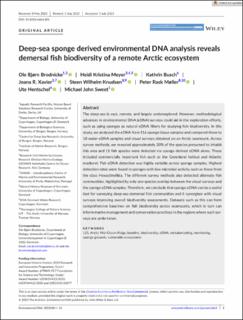| dc.contributor.author | Brodnicke, Ole Bjørn | |
| dc.contributor.author | Meyer, Heidi Kristina | |
| dc.contributor.author | Busch, Kathrin | |
| dc.contributor.author | Xavier, Joana R. | |
| dc.contributor.author | Knudsen, Steen Wilhelm | |
| dc.contributor.author | Møller, Peter Daniel Rask | |
| dc.contributor.author | Hentschel, Ute Humeida | |
| dc.contributor.author | Sweet, Michael John | |
| dc.date.accessioned | 2023-09-19T11:56:21Z | |
| dc.date.available | 2023-09-19T11:56:21Z | |
| dc.date.created | 2023-09-14T10:16:46Z | |
| dc.date.issued | 2023 | |
| dc.identifier.issn | 2637-4943 | |
| dc.identifier.uri | https://hdl.handle.net/11250/3090440 | |
| dc.description.abstract | The deep-sea is vast, remote, and largely underexplored. However, methodological advances in environmental DNA (eDNA) surveys could aid in the exploration efforts, such as using sponges as natural eDNA filters for studying fish biodiversity. In this study, we analyzed the eDNA from 116 sponge tissue samples and compared these to 18 water eDNA samples and visual surveys obtained on an Arctic seamount. Across survey methods, we revealed approximately 30% of the species presumed to inhabit this area and 11 fish species were detected via sponge derived eDNA alone. These included commercially important fish such as the Greenland halibut and Atlantic mackerel. Fish eDNA detection was highly variable across sponge samples. Highest detection rates were found in sponges with low microbial activity such as those from the class Hexactinellida. The different survey methods also detected alternate fish communities, highlighted by only one species overlap between the visual surveys and the sponge eDNA samples. Therefore, we conclude that sponge eDNA can be a useful tool for surveying deep-sea demersal fish communities and it synergises with visual surveys improving overall biodiversity assessments. Datasets such as this can form comprehensive baselines on fish biodiversity across seamounts, which in turn can inform marine management and conservation practices in the regions where such surveys are undertaken. | en_US |
| dc.language.iso | eng | en_US |
| dc.publisher | Wiley | en_US |
| dc.rights | Navngivelse-Ikkekommersiell 4.0 Internasjonal | * |
| dc.rights.uri | http://creativecommons.org/licenses/by-nc/4.0/deed.no | * |
| dc.title | Deep-sea sponge derived environmental DNA analysis reveals demersal fish biodiversity of a remote Arctic ecosystem | en_US |
| dc.type | Journal article | en_US |
| dc.type | Peer reviewed | en_US |
| dc.description.version | publishedVersion | en_US |
| dc.rights.holder | Copyright 2023 The Author(s) | en_US |
| cristin.ispublished | true | |
| cristin.fulltext | original | |
| cristin.qualitycode | 1 | |
| dc.identifier.doi | 10.1002/edn3.451 | |
| dc.identifier.cristin | 2174983 | |
| dc.source.journal | Environmental DNA | en_US |
| dc.identifier.citation | Environmental DNA. 2023. | en_US |

